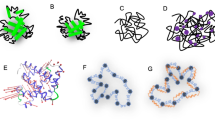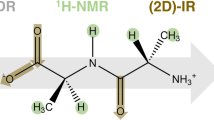Abstract
THE original conception of Speakman1-3 that salt linkages are important structural elements in micelles of fibrous proteins like keratin has been extended more recently4,5 to include molecules of globular proteins in aqueous solution. Although there is some vagdeness with respect to the exact physical character of the linkages in question, their hypo-thetical properties as outlined by Eyring and Stearn5 seem to classify them as hydrogen bonds between the ionizable amino and carboxylic groups of the side-chains of amino-acids (Mirsky and Pauling4). In such bonds the close approach of the opposite charges makes them appear as essentially neutral to the surroundings, and their instability in the presence of water requires that they are in protected positions inside the protein molecule4. Still, they are supposed to react with protons, and in Eyring and Steam's theory5, therefore, any protolytic reaction of a dissolved protein involves the breaking or formation of hydrogen bonds between carboxylic and amino groups. Since these bonds are regarded as characteristic of native proteins as distinct from denatured ones4,5, there is supposed to be an element of denaturation and renaturation in all protolytic reactions.
This is a preview of subscription content, access via your institution
Access options
Subscribe to this journal
Receive 51 print issues and online access
$199.00 per year
only $3.90 per issue
Buy this article
- Purchase on Springer Link
- Instant access to full article PDF
Prices may be subject to local taxes which are calculated during checkout
Similar content being viewed by others
References
Speakman, J. B., and Hirst, M. C., Nature, 128, 1073 (1931).
Speakman, J. B., and Scott, E., Trans. Farad. Soc., 30, 539 (1934).
Speakman, J. B., and Townend, F., Trans. Farad. Soc., 32, 897 (1936).
Mirsky, A. E., and Pauling, L., Proc. U.S. Nat. Acad. Sci., 22, 439 (1936).
Eyring, H., and Stearn, A. E., Chem. Rev., 24, 253 (1939).
Weber, H. H., and Nachmannsohn, D., Biochem. Z., 204, 215 (1929).
Weber, H. H., Biochem. Z., 218, 1 (1930).
Cohn, E. J., and Edsall, J. T., “Proteins, Amino-acids and Peptides", 155–195 (Reinhold Pub. Corp., New York, 1943).
Bjerrum, N., Z. physik. Chem., 104, 147 (1923).
Albrecht, G., and Corey, R. B., J. Amer. Chem. Soc., 61, 1087 (1939).
Svedberg, T., J. Amer. Chem. Soc., 47, 2673 (1924).
Linderstøm-Lang, K., and Jacobsen, C. F., C.R. Lab. Carlsberg Sér chim., 23, 179 (1940).
Linderstrøm-Lang, K., and Jacobsen, C. F., C.R. Lab. Carlsberg Sér chim., 24, 1 (1941).
Jacobsen, C. F., C.R. Lab. Carlsberg, Sér. chim., 26, 455 (1949).
Brand, E., Ann. New York Acad. Sci., 47, 187 (1946).
Haugaard, G., and Roberts, R. M., J. Amer. Chem. Soc., 64, 2864 (1942).
Author information
Authors and Affiliations
Rights and permissions
About this article
Cite this article
JACOESEN, C., LINDERSTRØM-LANG, K. Salt Linkages in Proteins. Nature 164, 411–412 (1949). https://doi.org/10.1038/164411a0
Issue Date:
DOI: https://doi.org/10.1038/164411a0
This article is cited by
-
Theoretical analysis on thermodynamic stability of chignolin
Scientific Reports (2019)
-
K. U. Linderstrøm-Lang
Ergebnisse der Physiologie Biologischen Chemie und Experimentellen Pharmakologie (1961)
Comments
By submitting a comment you agree to abide by our Terms and Community Guidelines. If you find something abusive or that does not comply with our terms or guidelines please flag it as inappropriate.



